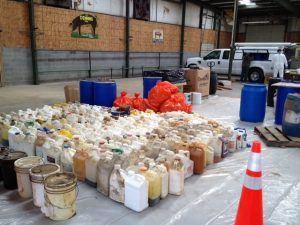
Photo credit: Derrick Bell, NCDA&CS
Many states run pesticide disposal programs specifically for farmers and commercial pesticide users, often referred to as “Pesticide Disposal Assistance” or “Clean Sweep” programs. Unwanted pesticides are collected at these state-funded drop-off events to ensure they are disposed of safely. The details of the programs – including the participants, the materials collected, how the materials are collected, and the collection dates – vary by state. Any pesticides intended for disposal or collection must be in a correctly labeled, structurally sound container. To learn about Clean Sweep programs in your state, see The Pesticide Stewardship Alliance’s State Pesticide Disposal Database.

Photo credit: Derrick Bell, NCDA&CS
In some states or some circumstances, it may be necessary to find a commercial disposal company with permits from the U.S. EPA to dispose of pesticide wastes in accordance with the Resource Conservation and Recovery Act (RCRA) and the U.S. DOT for proper packaging and transport in accordance with the Hazardous Materials Transportation Act (HMTA). If you need to use a commercial hazardous waste disposal service, contact several firms, compare costs (including transport fees), and ask for and check references. A commercial waste collector will ask you for an inventory of chemicals. All paperwork (manifests) generated by the disposal should be retained permanently because the person who generates hazardous waste (the pesticide user) is legally and financially responsible for that material for as long as it remains in existence. You cannot assume that disposal of a pesticide at a U.S. EPA-permitted facility eliminates all further legal responsibility for that product. Therefore, even though destructive disposal (incineration) may cost more than nondestructive disposal (landfilling), there are long-term benefits from choosing the incineration method.